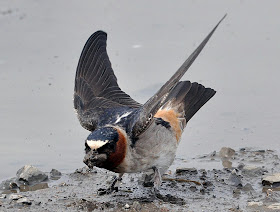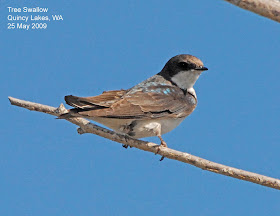In this era of human domination of the world, a successful
animal or plant may be defined as one that has adapted in some way to human
presence, even benefits by it.
Cliff Swallows (Petrochelidon
pyrrhonota) may be one of those animals. They build mud nests that they
attach to vertical substrates overhung sufficiently to provide shelter from
rain. They were able to evolve this nesting habit because of the widespread
abundance of rocky canyons in western North America. Cliff Swallows are still
abundant in that habitat.
The species was probably restricted to western canyonlands
until barns and bridges built by settlers advancing across the Great Plains a
few hundred years ago provided nesting substrates comparable to those provided
by nature. The birds took advantage of these newly furnished nest sites and
moved eastward, encountering more and more artificial cliffs and canyons as
they went. Today they nest through much of the East as well, on buildings but mostly
under big bridges across rivers.
Cliff Swallows are among the most social of land birds, with
colonies of up to 3,500 pairs reported. Their closely packed nests extend over
lengthy sections of cliff walls and can fill up the sides of barns and bridges
wherever there is overhead shelter. Because they nest so densely, they are more
subject than most birds to ectoparasites, especially swallow bugs and ticks, in
their nests. Because of high chick mortality from high densities of these
parasites, whole colonies are sometimes abandoned and the birds settle
elsewhere.
Their other "enemies" include House Sparrows,
which take over Cliff Swallow nests and even kill their young, and automobiles,
which take their toll of birds nesting adjacent to roads. Recent research has
shown that Cliff Swallows in such situations are evolving shorter wings, making
them more maneuverable and less likely to be struck down by a car.
Swallow nests are somewhat messy, because after about a week
old, the young defecate off the edge of the nest. A pile of poop can build up
rapidly below the nest, sometimes even blocking the entrance! Swallows that
nest where people live and work aren't always well loved because of this, and
whole colonies are sometimes removed from highway overpasses because of the mess
they make. Living around humans brings mixed benefits.
Dennis Paulson

6.jpg)






2.jpg)



